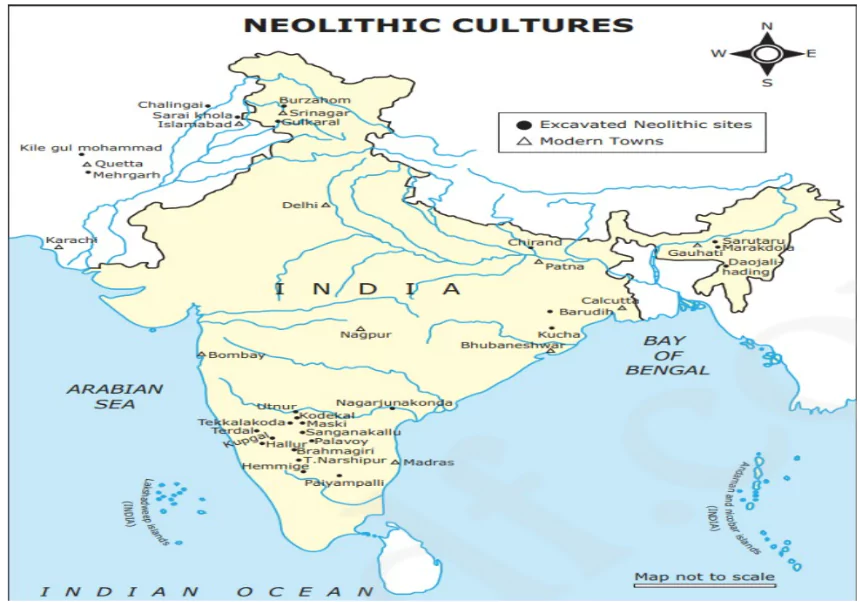|
Neolithic Sites and their Characteristics
|
- The Neolithic culture of north-western India is the earliest to have evidence of plant and animal domestication inIndia.
- Neolithic sites in Northwest India: Mehrgarh, Rana Ghundai, Sarai Kala and Jalilpur.
- Thesesites are now situated in Pakistan.
- Mehrgarh has produced evidence of early Neolithic times, dating to 7000 BC. Wheat and Barley were cultivated and sheep, goat and cattle were domesticated. This culture preceded the Indus Civilisation.
- 1st cultural phase (7000-5500 BC) of Mehrgarh – cultivated crops and domesticated animals, but did not use pottery.
- They cultivated six-row barley, emmer and einkorn wheat, jujube, ilanthai, and dates.
- They were semi-nomadic, pastoral groups, built their houses with mud and buried the dead.
- They used sea shells, limestone, turquoise, lapis lazuli, and sandstone ornaments.
- 2nd cultural phase (5500-4800 BC) and 3rd phase (4800-3500 BC) of Mehergarh
- They practised long-distance trade (revealed by Lapis Lazuli, which is available only in Badakshan).
- Evidence for pottery during these periods.
- Terracotta figurines and glazed faience beads have been found.
Early Dentistry in the Neolithic Mehrgarh
- From the Neolithic period, people began to eat ground grain and cooked food, which caused dental and other health problems.
- The earliest evidence for drilling human tooth (of a living person) has been found at Mehrgarh. It is seen as a prelude to dentistry.
|
Valley of Kashmir
- Burzahom, an important site of this culture, provides evidence for the Megalithic and Early Historic Periods.
- People lived in pit dwellings to escape the cold weather. The houses were oval in shape, wide at the bottom and narrow at the top.
- They used bone & stone tools. There was evidence of menhirs (standing stone) and the use of redware pottery and metal objects. They used copper arrowheads.
- The people practised agriculture and domesticated animals.
- Seeds of wheat, barley, common pea and lentil have been recovered from the excavations. The use of lentils suggests that they had contacts with Central Asia.
- They were contemporary to Harappa civilization and traded with them.
- Two phases of Neolithic culture have been identified. They are termed aceramic and ceramic phases. Aceramic phase did not have evidence of ceramics. The ceramic phase shows evidence of pottery.
- They also used black ware pottery, beads of agate and carnelian and painted pottery.
- A burial site produced wild dog bone and antler horn. An engraving of a hunting scene is depicted on a stone with a dog and sun.
|
Ganges Valley and Central India
- Lehuradeva, Chopani Munda, Koldiwa and Mahagara in Uttar Pradesh; Chirand and Senuwar in Bihar are major sites.
- The site of Lehuradeva (Uttar Pradesh) has produced early evidence of rice cultivation dated to 6500 BC.
- These sites also have evidence of pottery and plant and animal domestication. These sites are characterised by cord-marked pottery.
- Evidence for the cultivation of hulled and six-rowed barley, several types of wheat, rice, pea, green gram, and gram/chicken pea, mustard, flax/linseed and jackfruit have been found.
- Sheep, goat and cattle bones have been found besides bones of wild animals.
|
East India
- The Neolithic sites are found at many sites in Bihar and West Bengal.
- Birbhanpur, Chirand, Kuchai, Golbaisasan, and Sankarjang are important sites.
- Tools like pointed butt, celts, chisel and shouldered axes have been found.
|
South India (Andhra Pradesh, Karnataka and the North-western part of Tamil Nadu)
- Tools used include stone axes and blades.
- Fire-baked earthen figurines are found suggesting cattle keeping.
- These sites have ash mounds in the centre with settlements around them. Utnur and Palvoy in Andhra Pradesh and Kodekal, Kupgal and Budihal in Karnataka feature ash mound sites.
- These sites are found near the granite hills with water sources.
- These sites are found in the river valleys of Godavari, Krishna, Pennaru, Tungabhadra and Kaveri.
- Major sites include:
- Karnataka: Sanganakallu, Tekkalakota, Brahmagiri, Maski, Piklihal, Watkal, Hemmige and Hallur;
- Andhra Pradesh: Nagarjunakonda, Ramapuram, and Veerapuram;
- Tamil Nadu: Paiyyampalli.
|
North East India (Assam and Garo Hills)
- The culture dates from 2500-1500 BC.
- Tools like shouldered axes and splayed celts were found at the sites in Assam, Meghalaya, Nagaland and Arunachal Pradesh.
- Daojali Hading and Sarutaru are important sites bearing evidence for shifting cultivation.
- The cultivation of yams and taro, building stone and wooden memorials for the dead, and the presence of Austro-Asiatic languages are the marked features of this region.
|
![]() April 25, 2024
April 25, 2024
![]() 4254
4254
![]() 0
0
